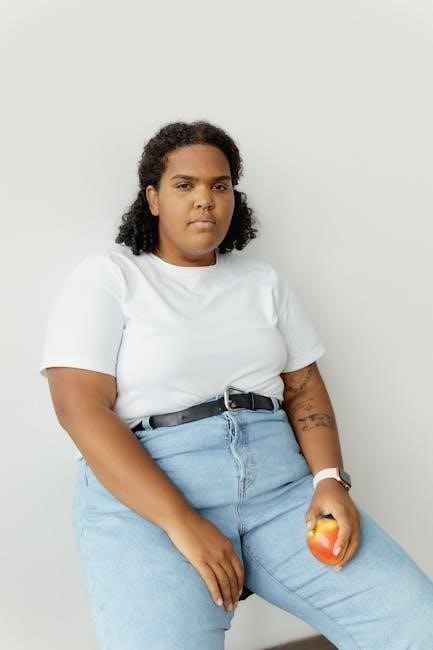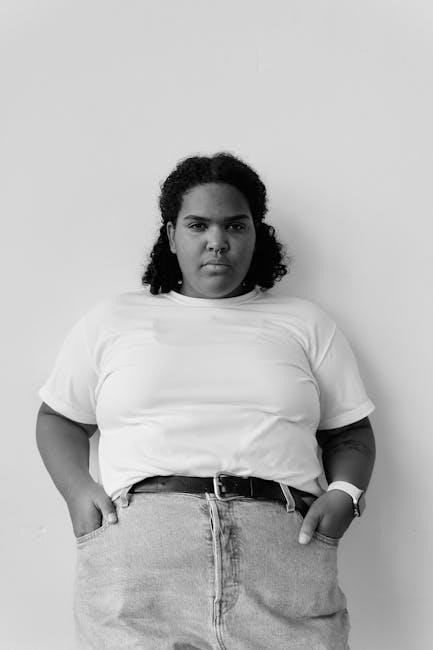A proper belt fit is essential for both functionality and style‚ ensuring comfort and enhancing your overall appearance. Understanding belt sizing helps you make informed choices.
1.1 Importance of Proper Belt Fit

A well-fitted belt ensures optimal comfort‚ functionality‚ and style. It supports your pants securely‚ prevents discomfort from tightness or constant adjustments‚ and enhances your overall appearance. Proper sizing also extends the belt’s longevity‚ as ill-fitting belts may stretch or wear unevenly. A good fit guarantees both practicality and polish‚ making it a crucial element in your wardrobe.
1.2 Aesthetic and Comfort Considerations
A well-chosen belt enhances both style and comfort‚ complementing your outfit while providing all-day support. The right width and material ensure a balance between aesthetics and functionality‚ allowing the belt to seamlessly integrate with formal or casual attire. Proper sizing avoids discomfort and ensures the belt remains a polished accessory‚ elevating your look without compromising on practicality.

How to Measure Your Waist for a Belt
Accurate waist measurement is key for the perfect belt fit. Use a tape measure around your natural waistline‚ ensuring it’s snug but not tight. This ensures comfort and proper sizing.
2.1 Step-by-Step Measurement Guide
Locate your natural waistline‚ typically above your hip bones and below your ribcage.
Wrap a flexible tape measure snugly around this area‚ ensuring it’s level and not twisted.
Take note of the measurement in inches.
If using pants‚ measure the waistband and add 2 inches for your belt size.
This method ensures accuracy and comfort for the perfect belt fit.
2.2 Tips for Accurate Waist Measurement
For accurate waist measurement‚ stand upright and relax your stomach.
Use a flexible tape measure and wrap it snugly around your natural waistline.
Ensure the tape is level and not twisted for consistent results.
Avoid measuring over loose clothing for precision.
If your measurement falls between sizes‚ round up for comfort.
Measure at the same time daily to account for natural fluctuations.
These tips ensure a precise fit‚ enhancing both comfort and style.

Using an Existing Belt to Determine Size
Measure from the buckle’s edge to the most used hole for accurate sizing.
Ensure the belt is flat and taut for consistent results.
This method ensures a precise fit‚ avoiding guesswork and discomfort.
3.1 Measuring from Buckle to Hole
To determine your belt size‚ measure from the buckle’s edge to the most used hole.
Lay the belt flat and pull it taut for accuracy.
This method ensures a precise fit‚ as it reflects your actual wearing comfort.
Use a flexible tape measure or a string to obtain an accurate length.
If your measurement falls between sizes‚ round up for the best fit.
This approach guarantees a comfortable and functional belt size tailored to your needs.
3.2 Excluding the Buckle in Measurements
When measuring an existing belt‚ exclude the buckle to focus on the usable length.
Start from where the buckle attaches to the leather and measure to the most frequently used hole.
This ensures accurate sizing‚ as the buckle can vary in size and throw.
Use a flexible tape measure or string for precision‚ keeping the belt flat and taut.
This method provides a clear‚ functional measurement for your ideal belt size.

Belt Size vs. Pant Size
Belt size is typically 2-3 inches larger than pant size for men and women‚ ensuring a comfortable fit. Measure where the belt will sit for accuracy.
4.1 The 2-3 Inch Rule Explained
The 2-3 inch rule states that your belt size should be 2-3 inches larger than your pant waist size. This ensures the belt fits comfortably without being too tight or loose. For example‚ if your pants are a 34 waist‚ choose a 36 belt. This rule applies to both men and women‚ though women may adjust based on where they wear the belt‚ such as at the waist or hips. This guideline ensures optimal comfort and functionality‚ allowing the belt to sit securely through the loops without restricting movement. By following this rule‚ you can determine your belt size accurately and enjoy a perfect fit that complements your outfit while providing the necessary support and style. This simple yet effective method is widely recommended for achieving the best results when selecting a belt size.
4.2 Exceptions and Additional Considerations
While the 2-3 inch rule is a general guideline‚ exceptions exist. For instance‚ plus-size individuals or those with larger builds might need a slightly larger belt size due to differences in body proportions. Additionally‚ the type of pants being worn‚ such as those with stretchy material‚ may require adjusting the belt size for comfort. Furthermore‚ some brands offer custom sizing options to cater to specific needs‚ ensuring a more personalized fit. It’s also important to consider the buckle style‚ as larger buckles may affect the overall fit and the placement of the holes. Taking these factors into account can help refine the belt size selection beyond the standard rule‚ ensuring both comfort and style are achieved. This approach allows for a more tailored fit that meets individual preferences and body types‚ making the belt sizing process more adaptable and effective.
Belt Length and Hole Placement
Belt length is typically measured from the end to the middle hole‚ ensuring proper fit and comfort. Accurate hole placement is crucial for functionality and style.
5.1 Measurement from End to Middle Hole
Measuring from the end of the belt to the middle hole ensures a balanced fit‚ avoiding excessive tightness or looseness. This method is standard across brands‚ providing consistency and reliability for accurate sizing.
5.2 Choosing the Right Size for Between Sizes
If your measurement falls between sizes‚ opt for the next larger size to ensure comfort and flexibility. This allows for a snug fit without restricting movement‚ accommodating fluctuations in waist size and ensuring optimal wearability.
Choosing the Right Belt Width
Belt width should complement your outfit and body type. Standard widths suit most attire‚ while personal style preferences may lead to narrower or wider choices.
6.1 Standard Widths and Clothing Suitability
Standard belt widths typically range from 1 inch to 1.5 inches‚ suitable for most clothing. A 1-inch belt is ideal for jeans and casual wear‚ while a 1.5-inch width complements dress pants. Ensure the belt width matches your pants’ style for a polished look‚ as wider belts may not fit dress pants properly.
6.2 Personal Style and Width Preferences
Personal style plays a significant role in choosing belt width‚ with options catering to different aesthetics. Slim belts (1 inch) suit minimalist looks‚ while wider belts (1.5 inches or more) offer a bold statement. Women often opt for narrower widths for a delicate appearance‚ while men may prefer wider belts for a rugged look. Custom widths are available for unique preferences.

Special Considerations for Different Body Types
Belt sizing varies by body type‚ with men often requiring adjustments for waistlines‚ women needing flexibility for waist or hip wear‚ and plus-size individuals prioritizing comfort.
7.1 Men’s Sizing Considerations
Men’s belt sizing typically aligns with pant waist size by adding 2-3 inches‚ ensuring comfort and functionality. Proper fit avoids restrictive tightness or excessive looseness‚ enhancing both style and comfort effectively while accommodating various body types and personal preferences for an optimal wearing experience.
7.2 Women’s Sizing Considerations
Women’s belt sizing varies by brand and style‚ requiring precise measurement. For waist belts‚ add 1-2 inches to your natural waist size. Hip belts add 3-4 inches. Consider the belt’s intended use—jeans‚ dresses‚ or formal wear—and choose a size that complements your outfit while ensuring comfort and a flattering fit.

7.3 Plus-Size Sizing Considerations
For plus-size individuals‚ belt sizing should prioritize comfort and support. Measure around the natural waistline or where the belt will sit. Choose a size that allows the belt to fasten securely without feeling tight. Adjustable or elastic belts can offer greater flexibility‚ ensuring a comfortable fit while maintaining style and functionality.

How Buckle Style Affects Sizing
Buckle styles influence belt sizing due to varying buckle throws and sizes. Larger buckles may require longer belts‚ while smaller ones offer more flexibility in fit adjustments.
8.1 Impact of Buckle Size on Fit
The size of the buckle can greatly affect how a belt fits. Larger buckles may require longer belts‚ while smaller ones provide more flexibility. Buckle throw‚ the distance from the bale to the prong‚ impacts sizing. Ensuring the buckle style complements your waist size and preferred fit is essential for both comfort and aesthetics. Proper measurement and buckle selection ensure an optimal fit.

8.2 Accommodating Buckle Throw
Buckle throw‚ the distance from the bale to the prong‚ impacts belt fit. Measure belts without including the buckle to ensure accurate sizing. When using a new buckle‚ consider its throw to avoid a too-tight or loose fit. Longer throws may require slightly longer belts for comfort and proper functionality. Always measure existing belts from the fold to the most-used hole for the best fit.
Material and Stretch Considerations
Material flexibility affects sizing‚ with leather belts stretching over time. Choose sizes that account for initial snugness‚ ensuring comfort as the material molds to your waist.
9.1 Material Flexibility and Sizing
Different materials offer varying levels of flexibility‚ impacting belt sizing. Leather belts‚ for instance‚ stretch with wear‚ so choosing a slightly tighter fit initially ensures optimal comfort later. Synthetic materials‚ like nylon‚ maintain their shape better and require precise measurements. Understanding your material’s flexibility helps in selecting the right size for a perfect‚ lasting fit.
9.2 Leather Stretch and Initial Sizing
Leather belts naturally stretch over time‚ so initial sizing should account for this. Start with a snug fit‚ as the leather will loosen slightly with use. Measure carefully and consider the buckle type‚ as larger buckles may require adjustments. Choosing the right size ensures long-term comfort and a secure fit‚ preventing the need for frequent adjustments later on.
Troubleshooting Common Sizing Issues
If your belt is too tight or loose‚ adjust by choosing a size closer to your waist measurement. Ensure accurate fit by considering material stretch and buckle type effects.
10.1 Addressing Too Tight or Too Loose Belts
If your belt feels too tight‚ consider sizing up for comfort. For a loose fit‚ opt for a smaller size. Ensure the belt has 2-6 inches of space when fastened. Materials like leather may stretch over time‚ so initial tightness can ease. Adjust based on how you prefer the fit—snug for support or relaxed for comfort. Proper adjustment ensures both functionality and style.
10.2 Adjusting Size Based on Experience
Over time‚ you may find your belt preferences evolve. If a belt feels too tight‚ consider sizing up. Conversely‚ if it’s too loose‚ opt for a smaller size. Experience teaches you to balance comfort and functionality‚ ensuring your belt supports your pants without restricting movement. Adjustments may also account for material stretch‚ like leather softening over time. Trust your comfort instincts to refine your fit.
Experience helps you recognize your ideal belt size. If you consistently find belts too tight or loose‚ adjust your size accordingly. Pay attention to how materials like leather soften and how your body changes. Use these insights to fine-tune your belt size for a perfect‚ personalized fit. Regularly checking your measurements ensures long-term comfort and satisfaction with your belt choice.
Accurate measurement and personal comfort are key to finding the perfect belt size. Always consider material flexibility and style preferences for a confident‚ polished look.
11.1 Key Takeaways for Best Fit
Ensure accurate measurements by using a tailor’s tape or existing belt as a guide. Consider material flexibility and personal comfort. Add 2-3 inches to pant size for men‚ while women should account for where the belt will sit. Choose a size that allows the belt to rest in the middle hole. Prioritize style and functionality‚ and remember‚ proper fit enhances both comfort and confidence in your appearance.
11.2 Encouragement for Proper Measurement
Taking the time to measure your waist accurately ensures a perfect fit‚ avoiding the hassle of returns or adjustments; With a well-fitted belt‚ you’ll enjoy both comfort and style‚ boosting your confidence and enhancing your overall appearance. So‚ grab a tape measure and ensure your belt is just right—you deserve the best fit and the confidence that comes with it!
